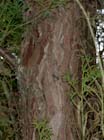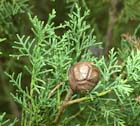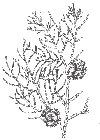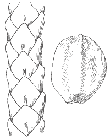Cupressus gigantea
W.C. Cheng et L.K. Fu 1975
Common names
巨柏 ju bai [Chinese]; Tsangpo River cypress.
Taxonomic notes
Syn.: Cupressus torulosa D. Don var. gigantea (W.C. Cheng et L.K.) Farjon 2005; Cupressus rushforthiana Maerki and Hoch (2021). Although Maerki and Hoch (2021) cite an old RAPD study (Rushforth et al. 2003) in support of species recognition for this taxon, their description of the type is based on a tree in an English garden, grown from the only recorded collection of this species in the field. It is therefore doubtful that C. rushforthiana exists as a distinct taxon in Tibet. The other genetic analyses Maerki and Hoch cite support recognition of this taxon as C. gigantea (Fu et al. 2019, Xu et al 2010), as does yet another genetic analysis, that of Xia et al. (2008).
Foliar terpene contents of the five Chinese Cupressus species indicates that C. gigantea is most distinct of the group, but otherwise reveals no obvious chemotaxonomic groupings (Cool et al. 1998).
Description
Trees usually 25 to 50 m tall and 100 to 600 cm dbh, at maturity. Crown irregularly conical to open. Bark fibrous, orange-brown, becaming dark brown and gray with narrow, thick, flat-topped ridges. Branchlets densely arranged, often glaucous, usually 4-angled, rarely terete, ultimate ones not drooping, 1.2-2 mm in diam. Leaves closely arranged, in 4 ranks, glaucous, scalelike, obtusely ridged or arched (gibbous) and with a rounded central abaxial gland. Seed cones usually glaucous, oblong-globose, 15-20 × 13-16 mm; approx. 12 cone scales, each fertile scale with numerous seeds; bracts with a prominent, large, free mucro at apex. 2n = 22 (Fu et al. 1999, Debreczy and Racz 2008).
Similar species include Cup. chengiana and Cup. torulosa. This species differs in having coarser, grey foliage, quadrangular branchlets, and larger cones (Debreczy and Racz 2008).
Distribution and Ecology
SE Tibet, in the Yarlung Zangbo (Tsangpo) River valley at 3,000-3,400 m elevation (Farjon 1998, Fu et al. 1999). It also grows in the Nyang and Nize River valleys (Debreczy and Racz 2011). See the Big Tree section for a Google Maps link where you can explore the distribution of groves along the valley. Hardy to Zone 8 (cold hardiness limit between -12.1°C and -6.7°C) (Bannister and Neuner 2001).
Remarkable Specimens
There is a very large tree in the town of Baji (or Bagyi, or Bajie), county of Nyingchi, Tibet that is widely celebrated as the largest specimen (see photo at right). It is usually called simply the Baji Cypress, but is also attributed as the God of Tree and the King Cypress (Wikipedia). It is said to have been planted thousands of years ago by the father of the Bon religion, and the grove is thus a sacred place (yet another case of trees having been saved from the axe for purely spiritual reasons). Its height is variously claimed as 46 to 56 m, its girth or diameter (I suspect that translations from the Chinese often confuse the two terms) as 446 to 1800 cm, and its age as 2,000 to 2,500 years (Dreams Travel 2008, PRC 2008, Wu and Puncog 2008). The age estimate is quite fanciful, as there are no data. It is the centerpiece of the Baji Giant Cypress Nature Reserve, which includes a substantial area (hundreds of trees, over 6,000 ha) of these trees, many of which are very large. The published information does not disclose any systematic efforts to measure these trees, so it is possible that larger or taller specimens remain undescribed.
The tree is located at 94.403° E, 29.622° N. Click HERE to open a window in Google Maps showing this tree. Or, right-click HERE and choose "save as.." for a KML file you can view in Google Earth (includes ground-level photos and other links). For both views, if you zoom out and explore a bit up and down the valley, you can see that there are numerous other scattered groves of large trees.
The tallest tree in the world outside of California (where Sequoia gets to over 115 m) is a cypress in the Yarlung Tsangpo gorge of Tibet, reported by Chinese scientists in May 2023 (Beijing News 2023, Global Times 2023). Following initial explorations dating as early as 2013, the tree was found on 2023.05.20 using LIDAR surveys performed by a drone, with further surveys performed to study the tree in detail. Measurements showed it to be 102.3 m tall and 293 cm dbh. The surveyors found another 25 trees over 90 m tall, as well. The species was reported as "Tibetan cypress" and other accounts variously named it as Cupressus torulosa or C. rushforthiana. The former name is an obsolete catchall term for Himalayan cypresses; C. torulosa as currently understood has a distribution well to the west of the Yarlung Tsangpo gorge. C. rushforthiana is discussed above (Taxonomic notes).
Ethnobotany
I have not found information on cultural uses, but the species has proven useful in science, where it has been used in dendroclimatic reconstructions (Wu 1992).
Observations
Remarks
Called an endangered species by Fu et al. (1999).
Citations
Cheng, W.C. and L. K. Fu. 1975. Species novae in Gymnospermae Sinicae. Acta Phytotaxonomica Sinica 13(4):85.
Cool, L.G., Z.L. Hu and E. Zavarin. 1998. Foliage terpenoids of Chinese Cupressus species. Biochemical Systematics and Ecology 26(8): 899-913.
Debreczy and Racz. 2011. Conifers Around The World. Dendropress.
Dreams Travel. 2008. Gigantic Cypress Wood,Cypress park,Cypress kingdom,Garden of Cypess. http://english.dreams-travel.com/guide/tibet/tibetnyingchi-gcypress.htm, accessed 2008.04.10.
Embassy of the People's Republic of China in India (PRC). 2008. Huge Cypress Forest in Nyingchi. http://www.chinaembassy.org.in/eng/lxzd/xzlyzn/Nyingchi/t174009.htm, accessed 2008.04.10, now defunct.
Fu, Yaru, Shaoke Li, Qiqiang Guo, Weilie Zheng, Rui Yang, and Huie Li. 2019. Genetic diversity and population structure of two endemic Cupressus (Cupressaceae) species on the Qinghai-Tibetan plateau. Journal of Genetics 98(1):14.
Global Times. 2023.05.28. Asia’s tallest tree at 102.3 meters found in SW China’s Xizang. https://www.globaltimes.cn/page/202305/1291477.shtml, accessed 2023.05.29.
Maerki, D. and J. Hoch. 2021. Cupressus rushforthii, a new cypress species in Xizang, China. Bulletin of the Cupressus Conservation Project 10(2):55-93.
Rushforth, K., R.P. Adams, M. Zhong, and R.N. Pandey. 2003. Variation among Cupressus species from the eastern hemisphere based on Random Amplified Polymorphic DNAs (RAPDs). Biochemical Systematics and Ecology 31(1):17-24.
Wu Xiangding. 1992. Dendroclimatic studies in China. P.432-445 in R.S. Bradley and P.D. Jones, eds., Climate Since A.D. 1500. London: Routledge Press.
Wu Yi and Soinam Puncog. 2008. Four Nature Reserves In Nyingchi. http://www.tibet.cn/tibetzt/tibet50-en/story/doc/story_909.htm, accessed 2008.04.10.
Xia, T., L. Meng, K. Mao, B. Tian, G. Miehe, and J. Liu. Genetic variation in the Qinghai-Tibetan plateau endemic and endangered conifer Cupressus gigantea, detected using RAPD and ISSR markers. Silvae Genetica 57:85-92.
Xu Tingting, Richard J. Abbott, Richard I. Milne, Kangshan Mao, Fang K. Du, Guili Wu, Zhaxi Ciren, Georg Miehe, and Jianquan Liu. 2010. Phylogeography and allopatric divergence of cypress species (Cupressus L.) in the Qinghai-Tibetan Plateau and adjacent regions. BMC Evolutionary Biology 10:1-10.
See also
Cheng, W.C. and L.K. Fu. in W. C. Cheng et al. 1975. Acta Phytotaxonomica Sinica 13(4): 85.
Farjon (2005) (as Cupressus torulosa var. gigantea).






